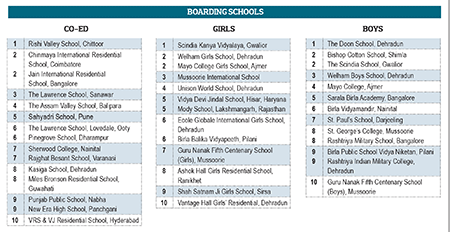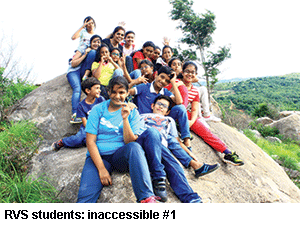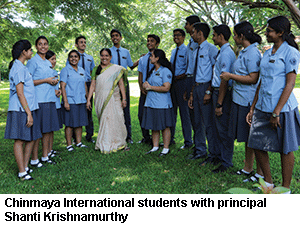For upper middle class households who believe in no-nonsense holistic, character building primary-secondary education in which the right balance is struck between academics, co-curricular and sports education in bracing climates, the country’s legacy boarding schools are still the preferred option
 Despite the criticism of trendy leftists and jholawallas that they are bastions of the elite, it’s a healthy feature of Indian democracy that the country’s traditional or legacy boarding schools, many of them established during the heyday of the British Raj, have not only survived, but flourished in independent India. For upper middle class Indian households which believe in no-nonsense holistic, character-building primary-secondary education in which the right balance is struck between academics and co-curricular and sports education in bracing climates — the majority of vintage legacy boarding schools are sited in the country’s unique hill stations — legacy boarding schools are still the preferred option. Moreover with air, noise, w
Despite the criticism of trendy leftists and jholawallas that they are bastions of the elite, it’s a healthy feature of Indian democracy that the country’s traditional or legacy boarding schools, many of them established during the heyday of the British Raj, have not only survived, but flourished in independent India. For upper middle class Indian households which believe in no-nonsense holistic, character-building primary-secondary education in which the right balance is struck between academics and co-curricular and sports education in bracing climates — the majority of vintage legacy boarding schools are sited in the country’s unique hill stations — legacy boarding schools are still the preferred option. Moreover with air, noise, w ater and automobile pollution of India’s 374 cities sliding from bad to worse, legacy boarding schools, which also tend to be more affordably priced than the new genre of international schools, are enjoying a new lease of life.
ater and automobile pollution of India’s 374 cities sliding from bad to worse, legacy boarding schools, which also tend to be more affordably priced than the new genre of international schools, are enjoying a new lease of life.
Yet the fact that today the number of respected co-ed boarding schools, which were a small minority in pre-independence India, is greater than the number of exclusively boys and girls boarding schools added together, is a telling indicator of the development of progressive and egalitarian attitudes in middle and upper middle class households in contemporary India. Unfortunately, the gender respect and egalitarianism that children learn in legacy (and international) boarding schools is the exception than rule in Indian education as testified by the rising incidence of gender crimes across the country.
It’s also a telling indicator of the intellectual distance India’s legacy boarding schools have travelled since the end of the British Raj, that the country’s top-ranked co-ed boarding school for the past five out of six years is the Chittoor (Andhra Pradesh)-based, home-grown Rishi Valley School (RVS, estb. 1924) which teaches its 360 boys and girls the nature-friendly and anti-consumerism philosophy and tenets of seer, educationist J. Krishnamurti (1895-1986).
Getting a reaction from Siddhartha Menon, an alum of Delhi University and IGNOU and principal of the school since 2013, to the consistent top rank awarded by EducationWorld/ C fore’s SEC ‘A’ respondents to RVS, is a difficult proposition. When interviewed in 2015, Menon expressed “perturbation” at the “increasingly widespread tendency to rank educational institutions” and claimed to be “mystified by the methodology”. Last year Menon delegated the task of responding to RVS’ #1 ranking to vice principal Dr. Anantha Jyoti who similarly expressed the opinion that “we don’t believe rating and ranking of schools or students serves much purpose”.
While it could be argued that the RVS management’s proclaimed modesty is a cover for refusal to share its best practices which could benefit India’s struggling primary-secondary sector, there’s no doubt that led by RVS, the six Krishnamurti schools across the country have evolved an alternative, indigenous model of school education which is exportable. The RVS promise enunciated on the school’s website, to “develop students’ intellectual faculties, (while making) a conscious effort towards creating a wider awareness of the world and giving space for the development of the aesthetic, moral and emotional dimensions... and (creating) self-aware, sensitive and responsible human beings who remain life-long learners”, has definitely resonated with the middle classes. Providing only vegetarian food and “simple but well-maintained” dormitory-style residential accommodation in a once barren 150-acre hillside transformed into an oasis of wetlands, forest and an awards-winning bird sanctuary, admission into RVS is subject to a rigorous parents interview and described as “very difficult” (tuition and board fees: Rs.4.30 lakh per year).
 As in 2016-17, the second rank in the co-ed boarding schools category this year is retained by another guruji school, the class V-XII Coimbatore-based Chinmaya International Residential School (CIRS, estb. 1996), which follows the teaching and tenets of Swami Chinmayanada (1916-1993). Under the able leadership of principal Shanti Krishnamurthy, this CBSE and IB affiliated school set on a salubrious 75-acre campus 28 km from Coimbatore, offers its 550 students “a unique fusion of the ancient and rich cultural heritage of the East, and the creative and independent thinking of the West”.
As in 2016-17, the second rank in the co-ed boarding schools category this year is retained by another guruji school, the class V-XII Coimbatore-based Chinmaya International Residential School (CIRS, estb. 1996), which follows the teaching and tenets of Swami Chinmayanada (1916-1993). Under the able leadership of principal Shanti Krishnamurthy, this CBSE and IB affiliated school set on a salubrious 75-acre campus 28 km from Coimbatore, offers its 550 students “a unique fusion of the ancient and rich cultural heritage of the East, and the creative and independent thinking of the West”.
However this year, CIRS has to share the #2 ranking with the Bangalore-based Jain International Residential School (JIRS, estb. 1999). On several parameters of education excellence, especially infrastructure and sports education, JIRS, promoted by Bangalore-based Chenraj Roychand, former Reliance Industries textiles salesman transformed into a powerhouse educationist and philanthropist (Jain University, Bhagwan Mahaveer Jain Hospital), is the mirror opposite of the guruji schools with no expense spared on providing state-of-the-art facilities. Indeed on the parameter of quality of infrastructure, JIRS is ranked #1 across all-boarding schools (co-ed, boys and girls) and higher than all international schools. And on the parameters of sports, safety and hygiene JIRs is ranked #1 among all co-ed boarding schools.
 “We are delighted to learn that the new millennium JIRS has been promoted to the country’s #2 co-ed boarding school in a league table which includes highly respected institutions, some of them over 150 years old. It’s very stimulating to note that our institution development efforts have been recognised by the huge number of respondents interviewed countrywide for the EducationWorld schools survey this year. The credit for this achievement should be given to the leadership and faculty of the school who have worked tirelessly to constantly improve our performance under each parameter of education excellence. We are committed to continuously upgrading JIRS to create a holistic development eco-system for our faculty and students,” says Roychand, promoter-chairman of JIRS. Currently the Bengaluru-based Jain Group of Institutions includes 85 education institutions.
“We are delighted to learn that the new millennium JIRS has been promoted to the country’s #2 co-ed boarding school in a league table which includes highly respected institutions, some of them over 150 years old. It’s very stimulating to note that our institution development efforts have been recognised by the huge number of respondents interviewed countrywide for the EducationWorld schools survey this year. The credit for this achievement should be given to the leadership and faculty of the school who have worked tirelessly to constantly improve our performance under each parameter of education excellence. We are committed to continuously upgrading JIRS to create a holistic development eco-system for our faculty and students,” says Roychand, promoter-chairman of JIRS. Currently the Bengaluru-based Jain Group of Institutions includes 85 education institutions.
In this year’s co-ed boarding schools Top 10 table, there are no surprises with the also superbly-equipped and managed Assam Valley School, Balipara, the vintage Lawrence Schools, Sanawar and Lovedale, the upwardly mobile Pinegrove, Dharampur, Kasiga School, Dehradun, and Miles Bronson Residential School, Guwahati (promoted to #8) — all excellent globally-benchmarked institutions — taking their appointed places at top table.
The major surprise is the low-profile class IV-XII CISCE-affiliated Punjab Public School, Nabha (PPSN, estb. 1960) which has risen high in this year’s league table from #13 in 2016-17 to #9. With high scores under the parameters of sports education and infrastructure, unsurprisingly PPSN, which is set in a scenic 120-acre campus and has an excellent reputation for its students’ equestrian skills, is also ranked the #1 co-ed boarding school of Punjab (pop. 30 million).
“I am happy to learn that your huge number of informed sample respondents have ranked PPSN among the Top 10 co-ed boarding schools in India, and #1 in Punjab. This recognition was perhaps overdue given the excellent academic — 48 of our 85 students who wrote the CISCE class XII exam this year averaged 90 percent plus — and sports facilities and record. Our campus is equipped with four hockey, seven football and three cricket grounds, three basketball, and two synthetic all-weather tennis, and two air-conditioned squash courts. Moreover, we are the pioneers in equestrian sports in North India with 38 thoroughbreds in our stables. In the national games, our students won 48 medals plus 57 in equestrian sports. There’s no doubt in my mind that we provide our students the most balanced education countrywide,” says Dr. Jagpreet Singh, a history and political science postgrad of Jaipur University who served with the consistently Top 5 ranked Mayo College, Ajmer for 23 years (1988-2011) rising to the position of vice principal prior to being appointed principal of PPSN six years ago. Currently, the wholly residential PPSN has 1,050 students, including 350 girls mentored by 142 teachers on its muster rolls (annual fee: Rs.3.25 lakh).
Beyond the Top 10 table, several other schools in this category have risen in the public esteem. Among them: Himali Boarding School, Kurseong to #13 from #15 in 2016-17; Asian School, Dehradun promoted to #13 (25); Taurian World School, Ranchi to #14 (15); Sela Qui International, Dehradun to #17 (23) with the Anubhuti School, Jalgaon completing the Top 20 of the 45-strong league table. (NB: only schools sufficiently well-known to be rated by at least 25 sample respondents are ranked).
Before concluding, it’s perhaps worthy of note that getting on to the Top 45 national league table of co-ed boarding schools is per se an achievement because schools which may be modestly ranked nationally could well be top ranked in their states. And given that most of India’s 29 states are as large and populous as European and African countries, that’s no mean achievement. Thus the Himali Boarding School which is ranked #13 nationally is the #1 co-ed boarding school in the state of West Bengal (pop. 91 million); Taurian World School ranked #14 is top ranked in Jharkhand (pop. 31.9 million) and the Sagar School, Alwar, ranked #22 nationally, is #1 in the state of Rajasthan (pop. 69 million). The point to note is that in EducationWorld we accord high value to state rankings, and top-ranked schools in the states will be awarded and celebrated at the EW India School Rankings Awards Nite to be held in Gurgaon on September 22-23.
To view Co-ed Boarding Schools Rankings 2017, please visit: http://www.educationworld.in/rank-school/all-cities/boarding-school/co-ed/2017.html